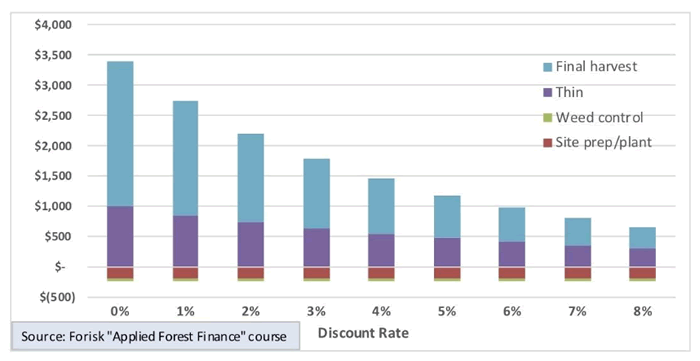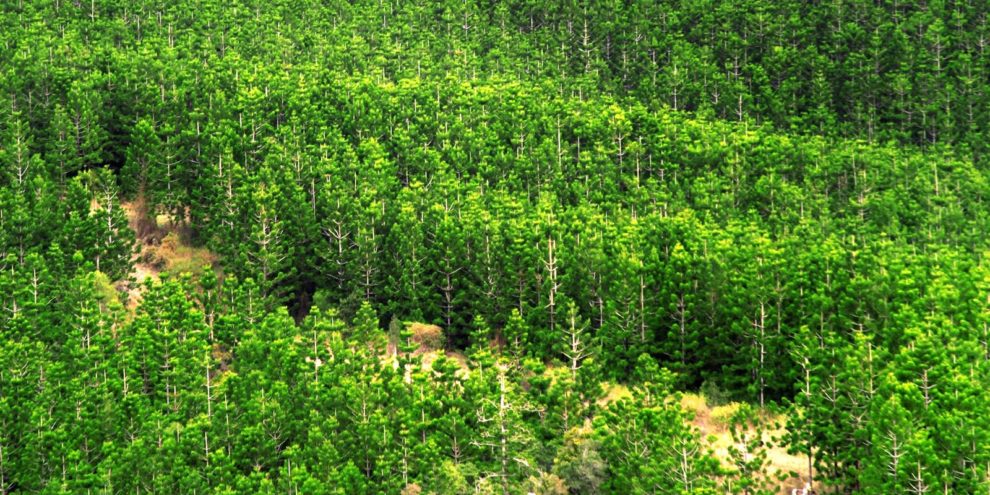Generally, discount rates represent the sum of a benchmark “risk-free” rate and a risk “premium.” That means, in forest finance, timberland values estimated using discounted cash flow (DCF) analysis get affected by (1) changes in the benchmark risk-free rate (e.g. U.S. Treasuries) and (2) the “premium” that investors require above this rate to hold the given asset, whether tracts of timberland, or something else like T-Bills or shares of T-Mobile.
Discount Rates
The risk-free rate and risk premium affect the discount rate, the numeric lightsaber analysts use to quantify risk and account for the time value of money. Generally, high discount rates reflect high risk and low discount rates indicate low risk. Overall, investors simply want to match the discount rate to the specific risk of a project.
Numbers outperform words when it comes to clarifying the critical role of discount rates in asset valuation. Consider the sensitivity analysis applied to a timberland investment in the figure below. In this example, the forest requires investments totaling $235 per acre within the first year, and then generates per acre cash flows of $1,000 in 15 years and $2,400 in 25 years. The undiscounted cash flows total $3,165 per acre. As we increase the discount rate, the net present value (NPV) falls, with the greatest declines taking place from changes in the lowest discount rates.
Net Present Value (NPV) at Different Discount Rates

Accounting for Risk with Low Interest Rates
Looking back, years of low interest rates encouraged borrowing by firms and justified low discount rates in DCF models across industries, including timberland. That creates the exposure captured in the figure above, where low rates magnify the effect on values from small changes in rates.
Looking forward, low discount rates in this type of analysis extends the relevance of risks and disruptions occurring far into the future. Think of the math at play here. Discounting $1,000 received in 50 years at 10% delivers $8.52 in present value, barely enough for a burger and fries. Discount that same $1,000 in 50 years at 1.43% (the yield on 30-year U.S. Treasuries as of July 1, 2020) equals $491.68 today.
At 10%, disruptions in 30 or 40 years have little impact on the analysis in terms of value today. At 1.43%, events in 30 or 40 years materially affect the net present value. In addition, the reduced impact of time on value from low discount rates creates an analytic tradeoff, turning once marginal projects into viable ones, even if nothing else changed in the assessment of the (timber) asset (or the local wood markets).
At the end of the day, we want the timberland valuation and the wood market analysis to stand up based on the merits of their (1) bottom-up facts and (2) top-down attractiveness relative to other assets and markets in that industry. The discount rate, in this view, is baselined to the long-term cyclical risk of the industry first and then adjusted to account for the specifics of the local forest asset and timber market.
This content may not be used or reproduced in any manner whatsoever, in part or in whole, without written permission of LANDTHINK. Use of this content without permission is a violation of federal copyright law. The articles, posts, comments, opinions and information provided by LANDTHINK are for informational and research purposes only and DOES NOT substitute or coincide with the advice of an attorney, accountant, real estate broker or any other licensed real estate professional. LANDTHINK strongly advises visitors and readers to seek their own professional guidance and advice related to buying, investing in or selling real estate.










Brooks,
Your next iteration of this article might have to include negative interest rates!